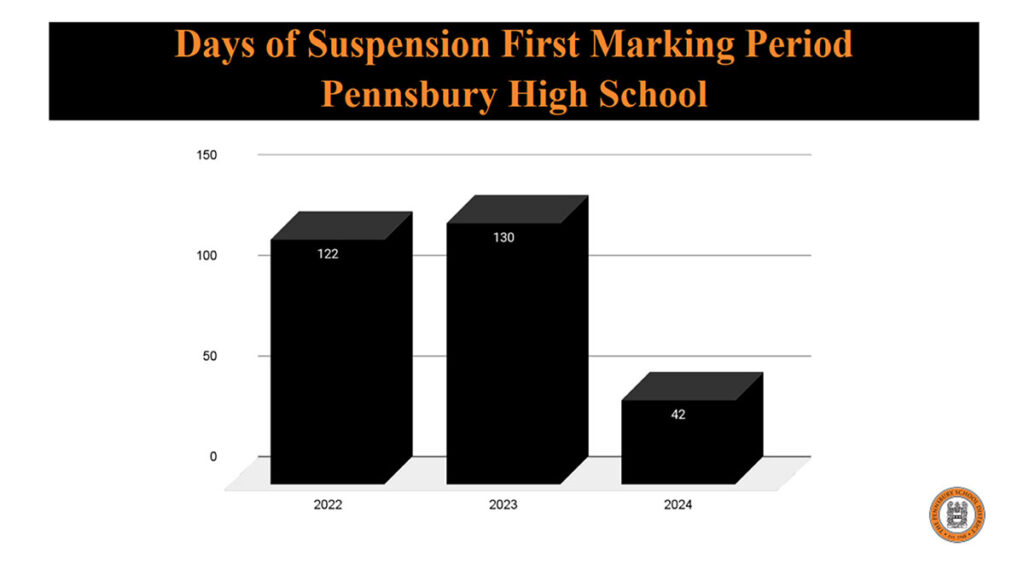Pennsbury has been under scrutiny for almost 5 years concerning its assessment of student discipline data by ethnicity and socioeconomic status. Doug Marshall first challenged the data, resulting in a First Amendment lawsuit that the district lost. Subsequently, the Pennsylvania Department of Education (PDE) cited and sanctioned Pennsbury for $720,000 for significant disproportionality in over-enrolling students of color in Special Education. Last August, the situation reached a peak when Pennsbury officials publicly admitted that the ethnicity data presented to the public differed from what was submitted to the PDE. The most recent questionable data, from January 16th, showed remarkable improvements that were celebrated as a success. However, is it too good to be true?
New Metrics Show Huge Decline in Discipline
During the Superintendent Report segment of the meeting, Tom Smith introduced the 2024 Annual Data Portfolio presentation, which was then handed over to Teri Ricci and Beth Aldridge. The presentation included underwhelming standardized test results that showed slight declines and had not yet recovered to pre-COVID levels. SAT combined scores also dropped to their lowest level in comparative period of 2019 to 2024. The Administration then addressed a major point of contention: the Discipline metrics. They highlighted extraordinary improvements, with a stunning year-over-year 68% decline in Days of Suspension at High School for the first marking period. The Middle School buildings saw a similar major decline of 34% in Days of Suspension

Questions arise about the feasibility of such a significant decline, as research data often indicate that such results may be driven by changes in reporting that lead to false positives. This is particularly likely when policy changes occur that influence the reporting of disciplinary incidents. During their presentation, district officials mentioned a few contributing factors but provided limited details on each factor’s impact. The highlighted slide below suggests that a collaborative approach between staff and students, combined with the implementation of Restorative Practices concepts, were key policy changes that contributed to the improvement.

Pennsbury Whistleblowers Alert Of False Data
As is customary within the Pennsbury Administration, whistleblower outreaches are made to inform vocal members of the public about concerns to address with the School Board. On January 24, 2025, the latest whistleblower outreach to members of PSD411 brought shocking allegations that the data is “fudged.” In the email shared below, the whistleblower claims that Pennsbury altered the length of suspensions for certain types of infractions to manipulate the numbers. These allegations align with the data presented, which showed a 68% decline in Days of Suspensions while there was only a 54% decline in the number of students suspended at the High School. The whistleblower also alleges that some incidents, such as fights, were not reported to fuel the lower numbers.

What Are Restorative Practices?
Restorative Practices in schools focus on creating a positive and inclusive school culture by fostering strong relationships, mutual respect, and a sense of community. These practices encompass a range of activities and approaches designed to engage students proactively and address conflicts when they arise. The goal is to shift the focus from punitive measures to restorative actions that promote understanding, accountability, and healing within the school community.
By employing Restorative Practices, schools aim to reduce the reliance on exclusionary discipline methods such as suspensions and expulsions. These practices encourage students to take responsibility for their actions, understand the impact of their behavior on others, and actively participate in resolving conflicts. For example, restorative circles allow all parties involved in a conflict to share their perspectives and work together to find a mutually agreeable solution. This collaborative approach helps build empathy and strengthens relationships among students and staff
Implementing Restorative Practices has been shown to reduce disciplinary incidents and improve the overall school climate. Research indicates that schools using these practices see a decrease in exclusionary discipline, a narrowing of racial disparities in disciplinary actions, and an increase in positive student behavior. Additionally, Restorative Practices can lead to improved academic outcomes, as students spend more time engaged in learning and less time out of the classroom due to disciplinary actions. Educators also benefit from a more supportive and collaborative environment, allowing them to focus on teaching and fostering student growth.
The YouTube video below was discovered in an RTK response submitted by Pennsbury, seeking communications related to their Restorative Practices efforts. The video highlights the shift made by Pennsbury, which has led to lower disciplinary numbers by simply embracing students with a “Love Sandwich”. These Restorative Practices concepts in the video are related to efforts at the Philadelphia School District, which recently came under scrutiny within the Biden Administration’s financial grants through the Department of Education.
What Happens If Restorative Practices Are Poorly Implemented
When Restorative Practices are implemented incorrectly or with bad intent to misrepresent discipline metrics, it undermines trust among students, staff, parents, and the broader community. Stakeholders rely on transparent and honest reporting to understand the true state of the school’s environment. Manipulating data for the sake of appearances can lead to a loss of credibility and integrity, making it difficult for future initiatives to gain support and cooperation.
If Restorative Practices are not genuinely integrated into the school’s culture and are instead used superficially to manipulate metrics, they will fail to address the underlying issues causing disciplinary problems. Without authentic efforts to foster understanding, accountability, and healing, conflicts and negative behaviors are likely to persist or even escalate. This can result in a cycle where disciplinary incidents are hidden rather than resolved, ultimately worsening the school’s climate.
Students and staff may feel disillusioned if they perceive that Restorative Practices are being used as a façade rather than as a meaningful approach to building a positive school culture. This can lead to a lack of engagement, morale decline, and a sense of injustice. Moreover, students who might benefit from genuine Restorative Practices miss out on opportunities for personal growth and improved relationships. The long-term consequences could include higher dropout rates, increased absenteeism, and overall disengagement from the school community.